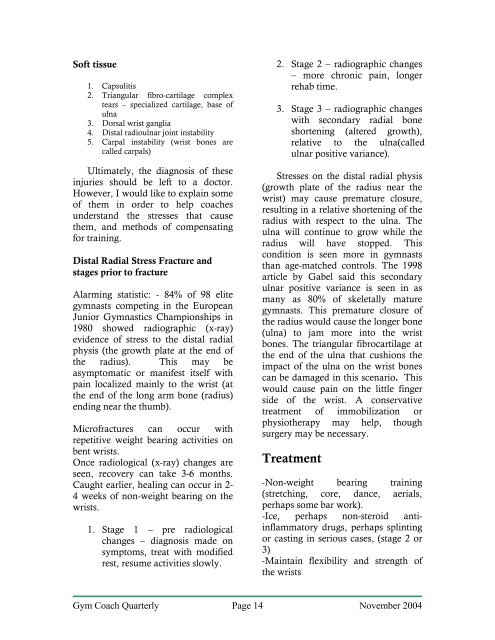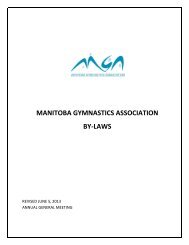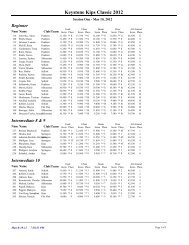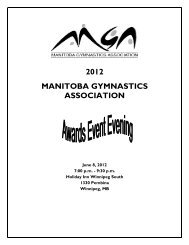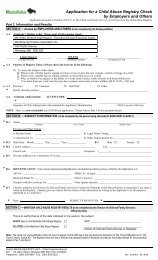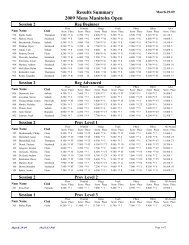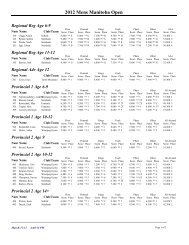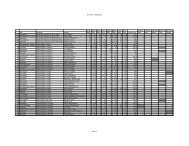View - Manitoba Gymnastics Association
View - Manitoba Gymnastics Association
View - Manitoba Gymnastics Association
You also want an ePaper? Increase the reach of your titles
YUMPU automatically turns print PDFs into web optimized ePapers that Google loves.
Soft tissue1. Capsulitis2. Triangular fibro-cartilage complextears – specialized cartilage, base ofulna3. Dorsal wrist ganglia4. Distal radioulnar joint instability5. Carpal instability (wrist bones arecalled carpals)Ultimately, the diagnosis of theseinjuries should be left to a doctor.However, I would like to explain someof them in order to help coachesunderstand the stresses that causethem, and methods of compensatingfor training.Distal Radial Stress Fracture andstages prior to fractureAlarming statistic: - 84% of 98 elitegymnasts competing in the EuropeanJunior <strong>Gymnastics</strong> Championships in1980 showed radiographic (x-ray)evidence of stress to the distal radialphysis (the growth plate at the end ofthe radius). This may beasymptomatic or manifest itself withpain localized mainly to the wrist (atthe end of the long arm bone (radius)ending near the thumb).Microfractures can occur withrepetitive weight bearing activities onbent wrists.Once radiological (x-ray) changes areseen, recovery can take 3-6 months.Caught earlier, healing can occur in 2-4 weeks of non-weight bearing on thewrists.1. Stage 1 – pre radiologicalchanges – diagnosis made onsymptoms, treat with modifiedrest, resume activities slowly.2. Stage 2 – radiographic changes– more chronic pain, longerrehab time.3. Stage 3 – radiographic changeswith secondary radial boneshortening (altered growth),relative to the ulna (calledulnar positive variance).Stresses on the distal radial physis(growth plate of the radius near thewrist) may cause premature closure,resulting in a relative shortening of theradius with respect to the ulna. Theulna will continue to grow while theradius will have stopped. Thiscondition is seen more in gymnaststhan age-matched controls. The 1998article by Gabel said this secondaryulnar positive variance is seen in asmany as 80% of skeletally maturegymnasts. This premature closure ofthe radius would cause the longer bone(ulna) to jam more into the wristbones. The triangular fibrocartilage atthe end of the ulna that cushions theimpact of the ulna on the wrist bonescan be damaged in this scenario. Thiswould cause pain on the little fingerside of the wrist. A conservativetreatment of immobilization orphysiotherapy may help, thoughsurgery may be necessary.Treatment-Non-weight bearing training(stretching, core, dance, aerials,perhaps some bar work).-Ice, perhaps non-steroid antiinflammatorydrugs, perhaps splintingor casting in serious cases, (stage 2 or3)-Maintain flexibility and strength ofthe wristsGym Coach Quarterly Page 14 November 2004


